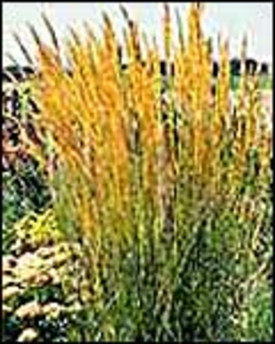
Reed Grass This trouble-free ornamental grass starts out in spring with a striking clump of narrow green leaves. Then the showy golden plumes appear in early summer and last well into winter—truly an all-season plant! ‘Karl Foerster’ grows 5 to 6 feet tall, with a spread of 2 to 3 feet. |
Grasses provide multi-season interest, with striking foliage and ornamental seedheads. Many have feathery plumes that make a welcome addition to cut flower arrangements.
Grasses and perennial flowers are naturals together. Look at any wild meadow, and you’ll likely find the two growing side by side. However, ornamental grasses differ from their wild cousins in a number of ways. First of all, ornamental grasses have been bred for a variety of foliage colors and forms, and many have very showy seedheads. Ornamental grasses are also better behaved than wild grasses—that is, they won’t spread wildly and take over entire beds.
Although grasses lack the large and colorful flowers of many ornamentals, their beauty is found in their foliage textures, colors, and forms. Not only does their straplike foliage provide striking contrast for flowering perennials, they also add vitality to a planting as they sway in the breeze.
Types of Grasses: Grasses can be categorized as either clumping and spreading. Clump-forming grasses form tidy mounds and spread slowly. Spreading grasses spread by creeping roots, and some can become invasive. When considering an ornamental grass, make sure it is classified as clump-forming, or at least described as slow-spreading. If you have your heart set on a variety, only to find out it can become invasive, consider sinking a large pot into the soil and planting it in there. The pot will contain the roots to limit spreading.
Choosing Grasses: Let’s look at some popular ornamental grass groups.
| Type of grass | Qualities | Example | ||
| feather reed grass
(Calamagrostis) |
• strongly vertical in form
• tough and adaptable • long bloom season
|

|
||
| blue fescue
(Festuca) |
• intense steel-blue color
• forms compact mounds • multiplies rapidly (but not invasive)
|

|
||
| Japanese Silver Grass
(Miscanthus) |
• graceful arching foliage
• feathery plumes • good for cut flowers • silver-green foliage and copper red plumes
|

Grass’ |
Caring for Ornamental Grasses: Like their cousins, the lawn grasses, ornamental grasses are generally relatively durable and reliable. Most grasses prefer full sun. They tend to be tolerant of a wide range of soil types and prefer a pH between 5 and 7. Once established, most ornamental grasses have deep, far-ranging root systems, making them resistant to drought. However, give them some extra TLC during their first season by watering them throughout dry spells. Ornamental grasses are also remarkably pest-free.
Like many perennials, grasses respond well to shearing back in late winter. Although you can also cut back dead foliage in fall, most grasses are attractive well into winter, and many have seedheads that attract birds. Whenever you decide to prune, simply cut down each clump to 3 to 6 inches above ground, using sharp scissors or pruners. In the spring, the grass will resprout from the crown.
Attractive Combinations:
 |
 |
|
| ‘Karl Foerster’
Reed Grass |
and
|
‘Autumn Joy’ Sedum |
 |
 |
|
| ‘Elijah Blue’ Fescuee |
and
|
‘Tumbling Waters’
Rose |
 |
 |
|
| ‘Sarabande’ Japanese
Silver Grass |
and
|
‘Single Mix’
Hollyhocks |
Credit: National Gardening Association




























